Report on Consumer Behavior: Critical Analysis of Tri-component Model
VerifiedAdded on 2020/06/03
|8
|1669
|95
Report
AI Summary
This report critically analyzes the tri-component model of consumer behavior, a framework that explains how attitudes are formed through cognitive, affective, and conative components. The introduction highlights the importance of understanding consumer behavior for business success, emphasizing that satisfying consumers is crucial for revenue growth. The main body delves into the model's components, providing examples such as Toyota's use of social media to enhance consumer knowledge and influence perceptions. The report also discusses how emotional states and intentions to buy affect consumer decisions, illustrating these points with scenarios like the choice between McDonald's and KFC. It examines how businesses can use the model to change consumer perceptions and behaviors through effective marketing strategies, with the conclusion summarizing the importance of these components in shaping consumer behavior and helping businesses. The report uses several examples to illustrate the use of the Tri component theory in understanding consumer behavior.
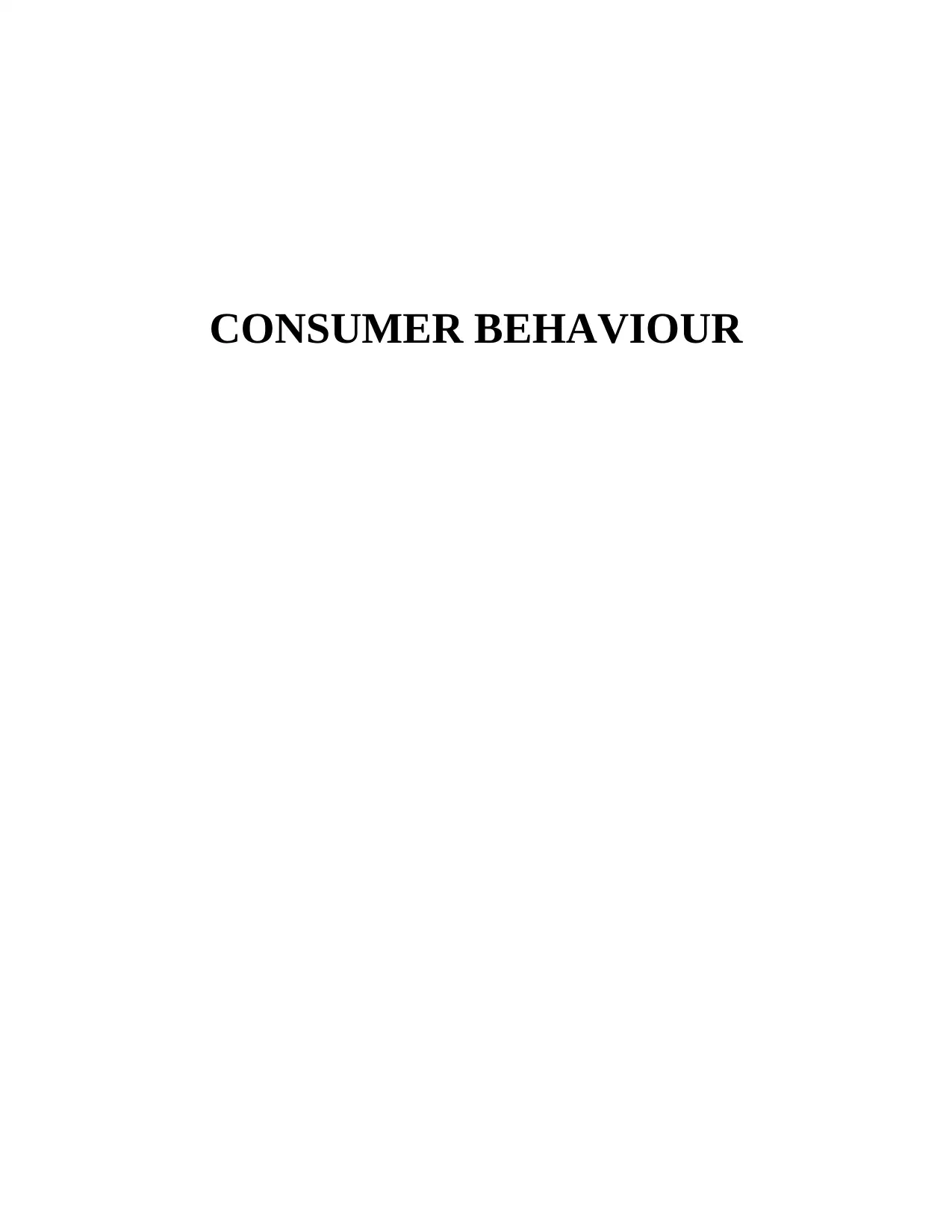
CONSUMER BEHAVIOUR
Paraphrase This Document
Need a fresh take? Get an instant paraphrase of this document with our AI Paraphraser
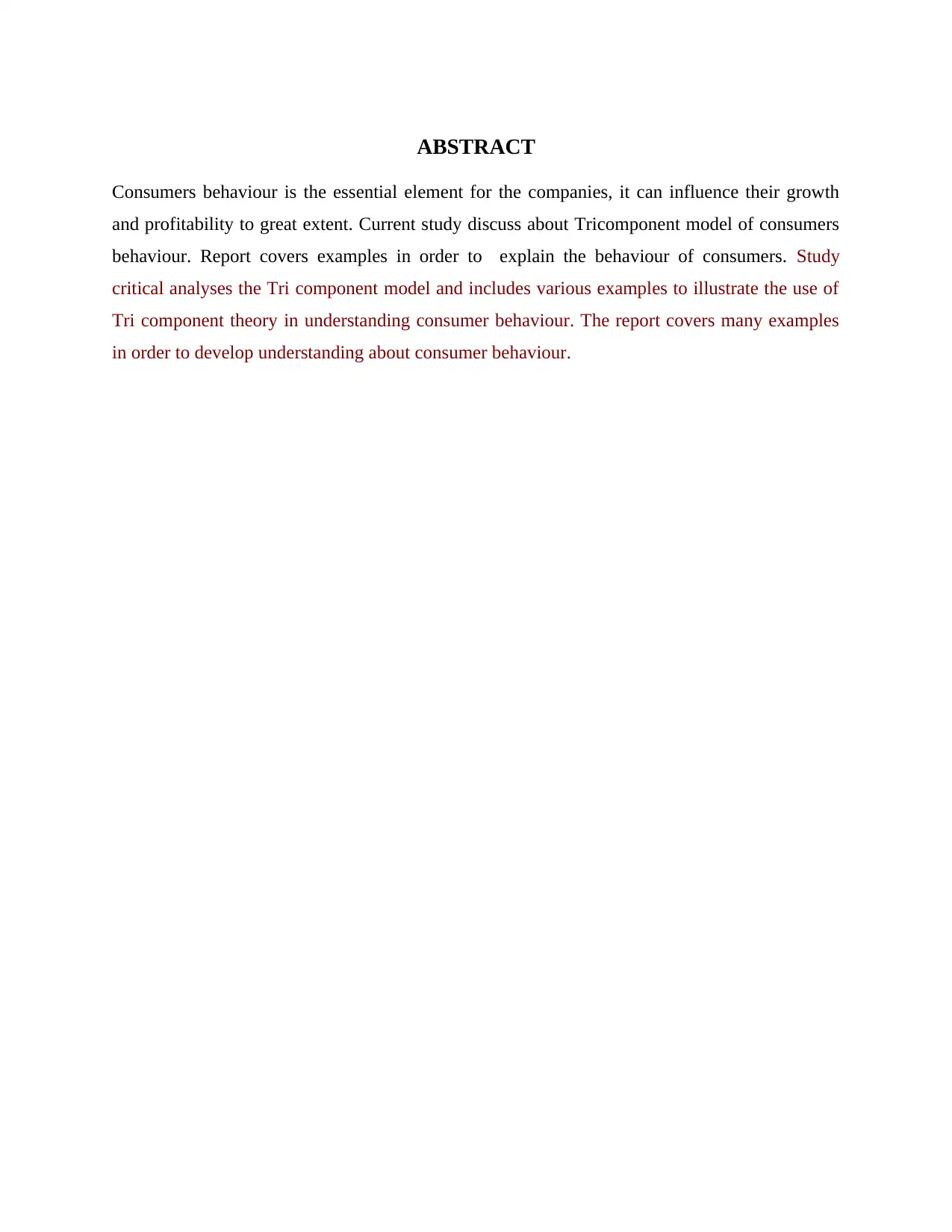
ABSTRACT
Consumers behaviour is the essential element for the companies, it can influence their growth
and profitability to great extent. Current study discuss about Tricomponent model of consumers
behaviour. Report covers examples in order to explain the behaviour of consumers. Study
critical analyses the Tri component model and includes various examples to illustrate the use of
Tri component theory in understanding consumer behaviour. The report covers many examples
in order to develop understanding about consumer behaviour.
Consumers behaviour is the essential element for the companies, it can influence their growth
and profitability to great extent. Current study discuss about Tricomponent model of consumers
behaviour. Report covers examples in order to explain the behaviour of consumers. Study
critical analyses the Tri component model and includes various examples to illustrate the use of
Tri component theory in understanding consumer behaviour. The report covers many examples
in order to develop understanding about consumer behaviour.
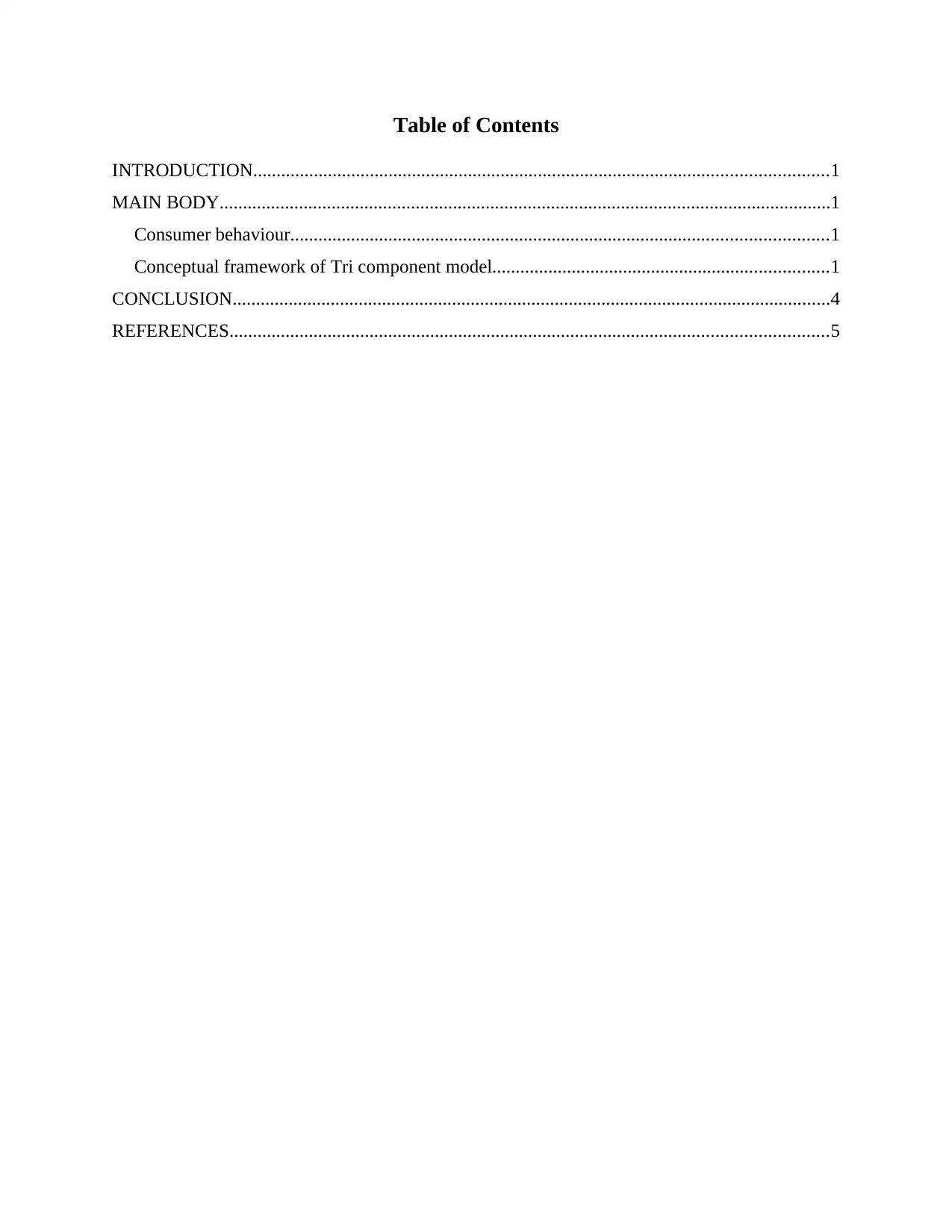
Table of Contents
INTRODUCTION...........................................................................................................................1
MAIN BODY...................................................................................................................................1
Consumer behaviour...................................................................................................................1
Conceptual framework of Tri component model........................................................................1
CONCLUSION................................................................................................................................4
REFERENCES................................................................................................................................5
INTRODUCTION...........................................................................................................................1
MAIN BODY...................................................................................................................................1
Consumer behaviour...................................................................................................................1
Conceptual framework of Tri component model........................................................................1
CONCLUSION................................................................................................................................4
REFERENCES................................................................................................................................5
⊘ This is a preview!⊘
Do you want full access?
Subscribe today to unlock all pages.

Trusted by 1+ million students worldwide
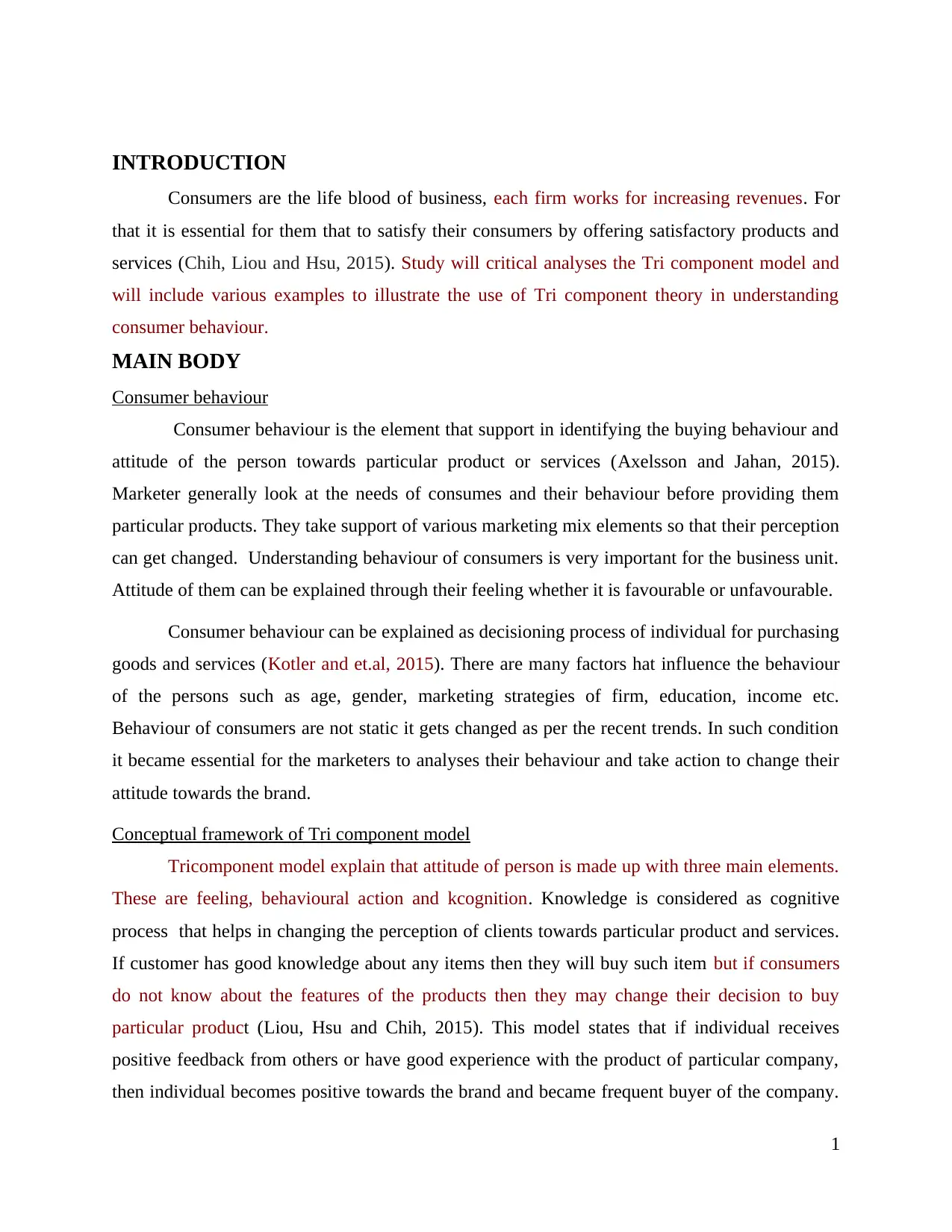
INTRODUCTION
Consumers are the life blood of business, each firm works for increasing revenues. For
that it is essential for them that to satisfy their consumers by offering satisfactory products and
services (Chih, Liou and Hsu, 2015). Study will critical analyses the Tri component model and
will include various examples to illustrate the use of Tri component theory in understanding
consumer behaviour.
MAIN BODY
Consumer behaviour
Consumer behaviour is the element that support in identifying the buying behaviour and
attitude of the person towards particular product or services (Axelsson and Jahan, 2015).
Marketer generally look at the needs of consumes and their behaviour before providing them
particular products. They take support of various marketing mix elements so that their perception
can get changed. Understanding behaviour of consumers is very important for the business unit.
Attitude of them can be explained through their feeling whether it is favourable or unfavourable.
Consumer behaviour can be explained as decisioning process of individual for purchasing
goods and services (Kotler and et.al, 2015). There are many factors hat influence the behaviour
of the persons such as age, gender, marketing strategies of firm, education, income etc.
Behaviour of consumers are not static it gets changed as per the recent trends. In such condition
it became essential for the marketers to analyses their behaviour and take action to change their
attitude towards the brand.
Conceptual framework of Tri component model
Tricomponent model explain that attitude of person is made up with three main elements.
These are feeling, behavioural action and kcognition. Knowledge is considered as cognitive
process that helps in changing the perception of clients towards particular product and services.
If customer has good knowledge about any items then they will buy such item but if consumers
do not know about the features of the products then they may change their decision to buy
particular product (Liou, Hsu and Chih, 2015). This model states that if individual receives
positive feedback from others or have good experience with the product of particular company,
then individual becomes positive towards the brand and became frequent buyer of the company.
1
Consumers are the life blood of business, each firm works for increasing revenues. For
that it is essential for them that to satisfy their consumers by offering satisfactory products and
services (Chih, Liou and Hsu, 2015). Study will critical analyses the Tri component model and
will include various examples to illustrate the use of Tri component theory in understanding
consumer behaviour.
MAIN BODY
Consumer behaviour
Consumer behaviour is the element that support in identifying the buying behaviour and
attitude of the person towards particular product or services (Axelsson and Jahan, 2015).
Marketer generally look at the needs of consumes and their behaviour before providing them
particular products. They take support of various marketing mix elements so that their perception
can get changed. Understanding behaviour of consumers is very important for the business unit.
Attitude of them can be explained through their feeling whether it is favourable or unfavourable.
Consumer behaviour can be explained as decisioning process of individual for purchasing
goods and services (Kotler and et.al, 2015). There are many factors hat influence the behaviour
of the persons such as age, gender, marketing strategies of firm, education, income etc.
Behaviour of consumers are not static it gets changed as per the recent trends. In such condition
it became essential for the marketers to analyses their behaviour and take action to change their
attitude towards the brand.
Conceptual framework of Tri component model
Tricomponent model explain that attitude of person is made up with three main elements.
These are feeling, behavioural action and kcognition. Knowledge is considered as cognitive
process that helps in changing the perception of clients towards particular product and services.
If customer has good knowledge about any items then they will buy such item but if consumers
do not know about the features of the products then they may change their decision to buy
particular product (Liou, Hsu and Chih, 2015). This model states that if individual receives
positive feedback from others or have good experience with the product of particular company,
then individual becomes positive towards the brand and became frequent buyer of the company.
1
Paraphrase This Document
Need a fresh take? Get an instant paraphrase of this document with our AI Paraphraser
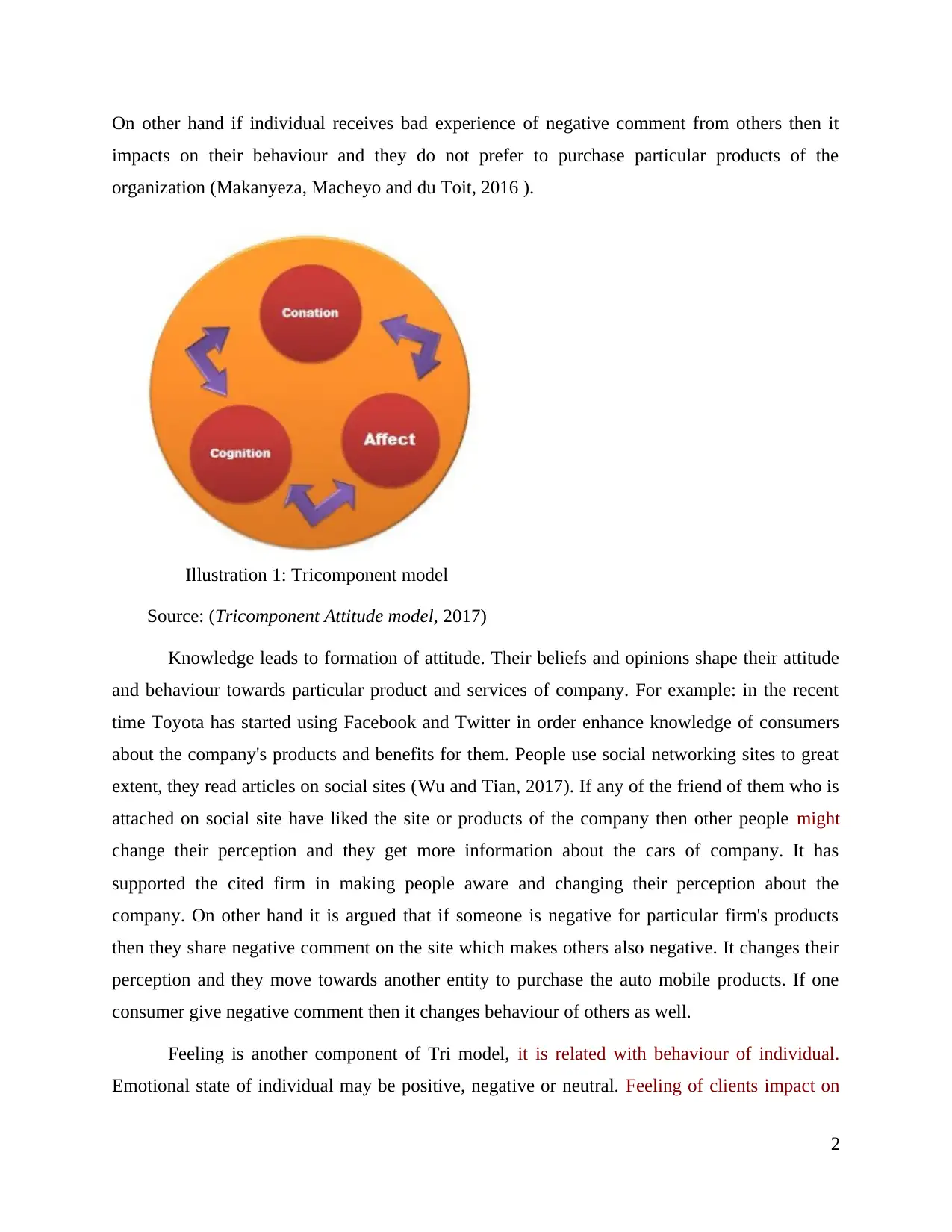
On other hand if individual receives bad experience of negative comment from others then it
impacts on their behaviour and they do not prefer to purchase particular products of the
organization (Makanyeza, Macheyo and du Toit, 2016 ).
Illustration 1: Tricomponent model
Source: (Tricomponent Attitude model, 2017)
Knowledge leads to formation of attitude. Their beliefs and opinions shape their attitude
and behaviour towards particular product and services of company. For example: in the recent
time Toyota has started using Facebook and Twitter in order enhance knowledge of consumers
about the company's products and benefits for them. People use social networking sites to great
extent, they read articles on social sites (Wu and Tian, 2017). If any of the friend of them who is
attached on social site have liked the site or products of the company then other people might
change their perception and they get more information about the cars of company. It has
supported the cited firm in making people aware and changing their perception about the
company. On other hand it is argued that if someone is negative for particular firm's products
then they share negative comment on the site which makes others also negative. It changes their
perception and they move towards another entity to purchase the auto mobile products. If one
consumer give negative comment then it changes behaviour of others as well.
Feeling is another component of Tri model, it is related with behaviour of individual.
Emotional state of individual may be positive, negative or neutral. Feeling of clients impact on
2
impacts on their behaviour and they do not prefer to purchase particular products of the
organization (Makanyeza, Macheyo and du Toit, 2016 ).
Illustration 1: Tricomponent model
Source: (Tricomponent Attitude model, 2017)
Knowledge leads to formation of attitude. Their beliefs and opinions shape their attitude
and behaviour towards particular product and services of company. For example: in the recent
time Toyota has started using Facebook and Twitter in order enhance knowledge of consumers
about the company's products and benefits for them. People use social networking sites to great
extent, they read articles on social sites (Wu and Tian, 2017). If any of the friend of them who is
attached on social site have liked the site or products of the company then other people might
change their perception and they get more information about the cars of company. It has
supported the cited firm in making people aware and changing their perception about the
company. On other hand it is argued that if someone is negative for particular firm's products
then they share negative comment on the site which makes others also negative. It changes their
perception and they move towards another entity to purchase the auto mobile products. If one
consumer give negative comment then it changes behaviour of others as well.
Feeling is another component of Tri model, it is related with behaviour of individual.
Emotional state of individual may be positive, negative or neutral. Feeling of clients impact on
2
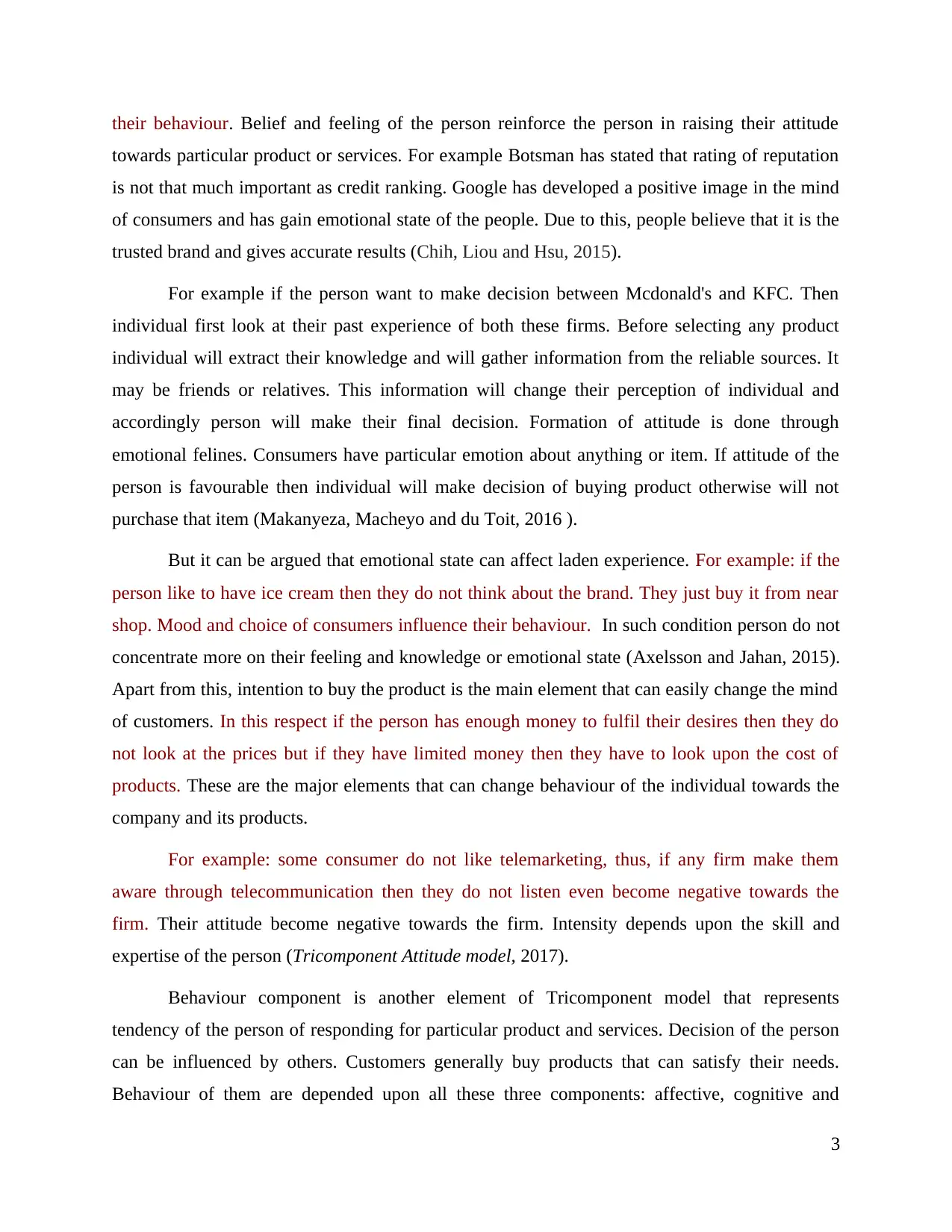
their behaviour. Belief and feeling of the person reinforce the person in raising their attitude
towards particular product or services. For example Botsman has stated that rating of reputation
is not that much important as credit ranking. Google has developed a positive image in the mind
of consumers and has gain emotional state of the people. Due to this, people believe that it is the
trusted brand and gives accurate results (Chih, Liou and Hsu, 2015).
For example if the person want to make decision between Mcdonald's and KFC. Then
individual first look at their past experience of both these firms. Before selecting any product
individual will extract their knowledge and will gather information from the reliable sources. It
may be friends or relatives. This information will change their perception of individual and
accordingly person will make their final decision. Formation of attitude is done through
emotional felines. Consumers have particular emotion about anything or item. If attitude of the
person is favourable then individual will make decision of buying product otherwise will not
purchase that item (Makanyeza, Macheyo and du Toit, 2016 ).
But it can be argued that emotional state can affect laden experience. For example: if the
person like to have ice cream then they do not think about the brand. They just buy it from near
shop. Mood and choice of consumers influence their behaviour. In such condition person do not
concentrate more on their feeling and knowledge or emotional state (Axelsson and Jahan, 2015).
Apart from this, intention to buy the product is the main element that can easily change the mind
of customers. In this respect if the person has enough money to fulfil their desires then they do
not look at the prices but if they have limited money then they have to look upon the cost of
products. These are the major elements that can change behaviour of the individual towards the
company and its products.
For example: some consumer do not like telemarketing, thus, if any firm make them
aware through telecommunication then they do not listen even become negative towards the
firm. Their attitude become negative towards the firm. Intensity depends upon the skill and
expertise of the person (Tricomponent Attitude model, 2017).
Behaviour component is another element of Tricomponent model that represents
tendency of the person of responding for particular product and services. Decision of the person
can be influenced by others. Customers generally buy products that can satisfy their needs.
Behaviour of them are depended upon all these three components: affective, cognitive and
3
towards particular product or services. For example Botsman has stated that rating of reputation
is not that much important as credit ranking. Google has developed a positive image in the mind
of consumers and has gain emotional state of the people. Due to this, people believe that it is the
trusted brand and gives accurate results (Chih, Liou and Hsu, 2015).
For example if the person want to make decision between Mcdonald's and KFC. Then
individual first look at their past experience of both these firms. Before selecting any product
individual will extract their knowledge and will gather information from the reliable sources. It
may be friends or relatives. This information will change their perception of individual and
accordingly person will make their final decision. Formation of attitude is done through
emotional felines. Consumers have particular emotion about anything or item. If attitude of the
person is favourable then individual will make decision of buying product otherwise will not
purchase that item (Makanyeza, Macheyo and du Toit, 2016 ).
But it can be argued that emotional state can affect laden experience. For example: if the
person like to have ice cream then they do not think about the brand. They just buy it from near
shop. Mood and choice of consumers influence their behaviour. In such condition person do not
concentrate more on their feeling and knowledge or emotional state (Axelsson and Jahan, 2015).
Apart from this, intention to buy the product is the main element that can easily change the mind
of customers. In this respect if the person has enough money to fulfil their desires then they do
not look at the prices but if they have limited money then they have to look upon the cost of
products. These are the major elements that can change behaviour of the individual towards the
company and its products.
For example: some consumer do not like telemarketing, thus, if any firm make them
aware through telecommunication then they do not listen even become negative towards the
firm. Their attitude become negative towards the firm. Intensity depends upon the skill and
expertise of the person (Tricomponent Attitude model, 2017).
Behaviour component is another element of Tricomponent model that represents
tendency of the person of responding for particular product and services. Decision of the person
can be influenced by others. Customers generally buy products that can satisfy their needs.
Behaviour of them are depended upon all these three components: affective, cognitive and
3
⊘ This is a preview!⊘
Do you want full access?
Subscribe today to unlock all pages.

Trusted by 1+ million students worldwide
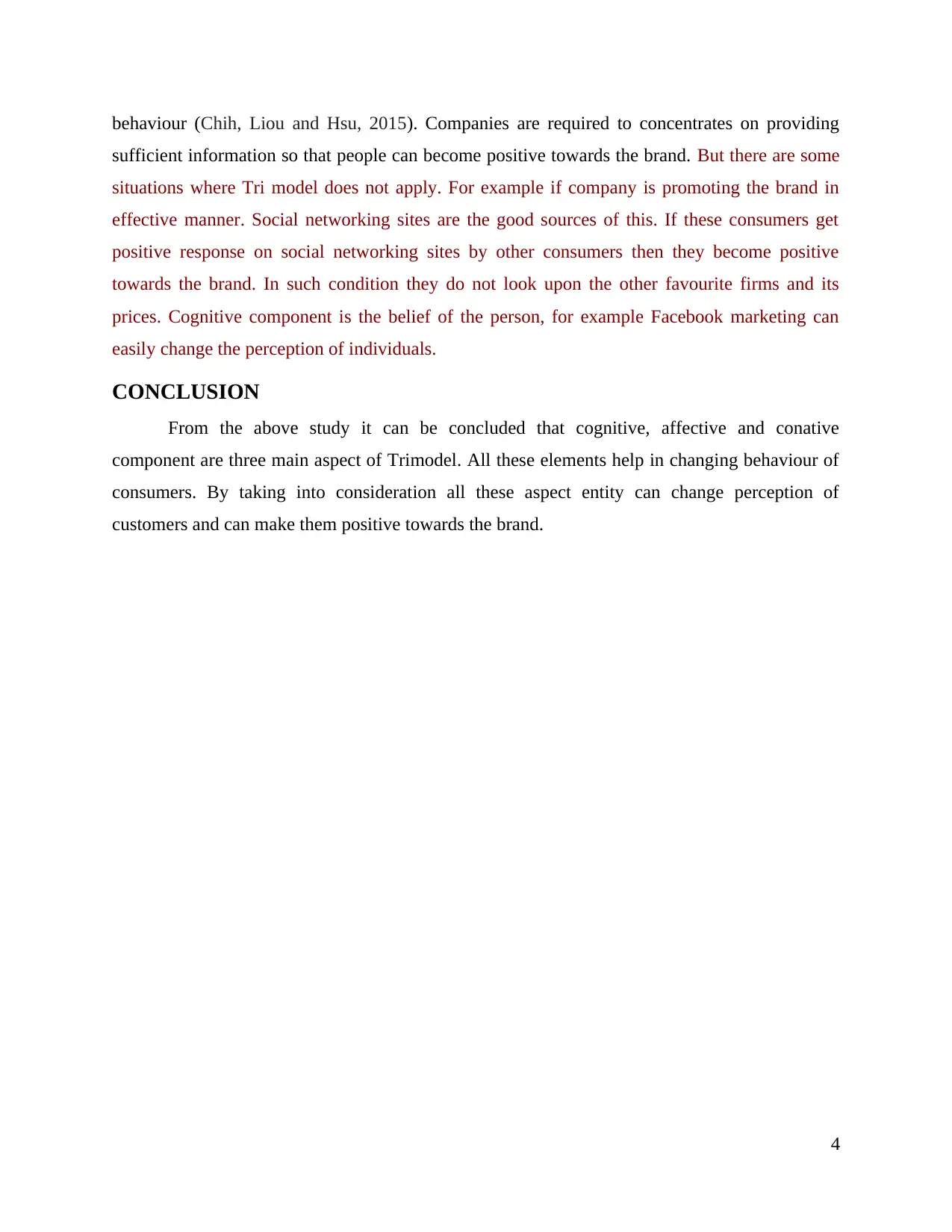
behaviour (Chih, Liou and Hsu, 2015). Companies are required to concentrates on providing
sufficient information so that people can become positive towards the brand. But there are some
situations where Tri model does not apply. For example if company is promoting the brand in
effective manner. Social networking sites are the good sources of this. If these consumers get
positive response on social networking sites by other consumers then they become positive
towards the brand. In such condition they do not look upon the other favourite firms and its
prices. Cognitive component is the belief of the person, for example Facebook marketing can
easily change the perception of individuals.
CONCLUSION
From the above study it can be concluded that cognitive, affective and conative
component are three main aspect of Trimodel. All these elements help in changing behaviour of
consumers. By taking into consideration all these aspect entity can change perception of
customers and can make them positive towards the brand.
4
sufficient information so that people can become positive towards the brand. But there are some
situations where Tri model does not apply. For example if company is promoting the brand in
effective manner. Social networking sites are the good sources of this. If these consumers get
positive response on social networking sites by other consumers then they become positive
towards the brand. In such condition they do not look upon the other favourite firms and its
prices. Cognitive component is the belief of the person, for example Facebook marketing can
easily change the perception of individuals.
CONCLUSION
From the above study it can be concluded that cognitive, affective and conative
component are three main aspect of Trimodel. All these elements help in changing behaviour of
consumers. By taking into consideration all these aspect entity can change perception of
customers and can make them positive towards the brand.
4
Paraphrase This Document
Need a fresh take? Get an instant paraphrase of this document with our AI Paraphraser
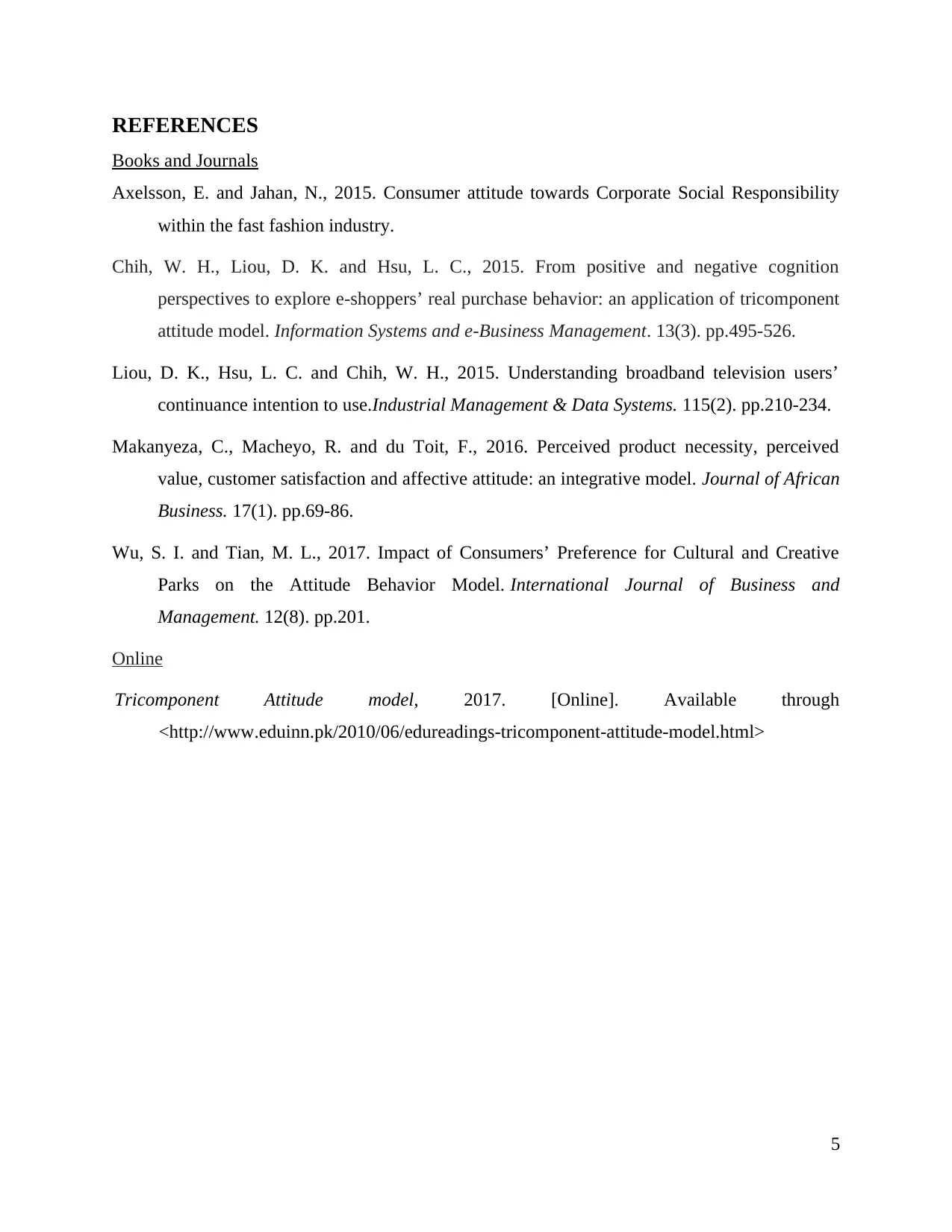
REFERENCES
Books and Journals
Axelsson, E. and Jahan, N., 2015. Consumer attitude towards Corporate Social Responsibility
within the fast fashion industry.
Chih, W. H., Liou, D. K. and Hsu, L. C., 2015. From positive and negative cognition
perspectives to explore e-shoppers’ real purchase behavior: an application of tricomponent
attitude model. Information Systems and e-Business Management. 13(3). pp.495-526.
Liou, D. K., Hsu, L. C. and Chih, W. H., 2015. Understanding broadband television users’
continuance intention to use.Industrial Management & Data Systems. 115(2). pp.210-234.
Makanyeza, C., Macheyo, R. and du Toit, F., 2016. Perceived product necessity, perceived
value, customer satisfaction and affective attitude: an integrative model. Journal of African
Business. 17(1). pp.69-86.
Wu, S. I. and Tian, M. L., 2017. Impact of Consumers’ Preference for Cultural and Creative
Parks on the Attitude Behavior Model. International Journal of Business and
Management. 12(8). pp.201.
Online
Tricomponent Attitude model, 2017. [Online]. Available through
<http://www.eduinn.pk/2010/06/edureadings-tricomponent-attitude-model.html>
5
Books and Journals
Axelsson, E. and Jahan, N., 2015. Consumer attitude towards Corporate Social Responsibility
within the fast fashion industry.
Chih, W. H., Liou, D. K. and Hsu, L. C., 2015. From positive and negative cognition
perspectives to explore e-shoppers’ real purchase behavior: an application of tricomponent
attitude model. Information Systems and e-Business Management. 13(3). pp.495-526.
Liou, D. K., Hsu, L. C. and Chih, W. H., 2015. Understanding broadband television users’
continuance intention to use.Industrial Management & Data Systems. 115(2). pp.210-234.
Makanyeza, C., Macheyo, R. and du Toit, F., 2016. Perceived product necessity, perceived
value, customer satisfaction and affective attitude: an integrative model. Journal of African
Business. 17(1). pp.69-86.
Wu, S. I. and Tian, M. L., 2017. Impact of Consumers’ Preference for Cultural and Creative
Parks on the Attitude Behavior Model. International Journal of Business and
Management. 12(8). pp.201.
Online
Tricomponent Attitude model, 2017. [Online]. Available through
<http://www.eduinn.pk/2010/06/edureadings-tricomponent-attitude-model.html>
5
1 out of 8
Related Documents
Your All-in-One AI-Powered Toolkit for Academic Success.
+13062052269
info@desklib.com
Available 24*7 on WhatsApp / Email
![[object Object]](/_next/static/media/star-bottom.7253800d.svg)
Unlock your academic potential
Copyright © 2020–2025 A2Z Services. All Rights Reserved. Developed and managed by ZUCOL.



